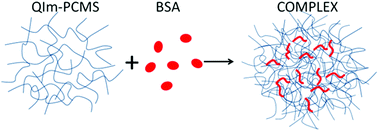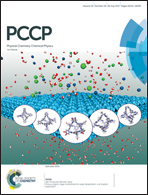Tuning the solution organization of cationic polymers through interactions with bovine serum albumin†
Abstract
The interactions of bovine serum albumin (BSA) with aggregates of cationic polymers, i.e. quaternized poly(chloromethyl styrene) chains (QIm-PCMS), in aqueous solutions are investigated using small angle neutron scattering on length scales relevant to the size of BSA. The arrangement of the macromolecular chains within their aggregates is consistent with a blob description of overlapping chains that contain hydrophobic domains. The local conformations depend on the salt content as in typical linear polyelectrolytes. Although the hydrophobic content of the cationic polymers does not cause measurable local morphology differences, the interactions with BSA are enhanced in the case of the not fully quaternized polymer. The secondary structure of BSA is critically compromised by the interaction with the quaternized polymers as the signature of the alpha helix conformation is lost. The complexation with BSA and the resulting enhancement of interchain associations on higher length scales are verified using dynamic light scattering experiments. This study demonstrates the ability to tune the polyelectrolyte/protein interactions and polyelectrolyte chain–chain associations by modifying the hydrophobic content of the polyelectrolytes.



 Please wait while we load your content...
Please wait while we load your content...